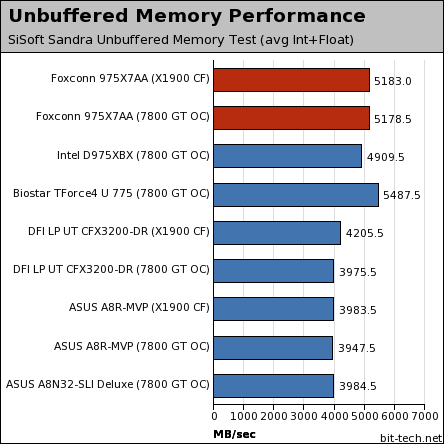Testing Methods:
With the exception of SiSoft Sandra's unbuffered memory bandwidth benchmark - which, incidentally, measures real memory bandwidth when you need it most - all of our benchmarks have been engineered to give you numbers that you are likely to find useful when actually using the products we have evaluated in the real world. There are plans to increase the number of benchmarks over time and we're running additional tests that will not be published until we have enough products to make a reasonable comparison.We are also focusing a lot more of our time on evaluating the stability of the motherboards (and platforms) using a stress test designed to highlight any of the potential weaknesses that the product may have. That involves a gradually increasing amount of stress starting with Prime95 and expanding to IOMeter and 3DMark05 if all is well. This is to ensure that all parts of the system are stressed simultaneously over a period of time.
We believe that the consumer is never likely to subject their platform to this level of stress and we are not expecting every product to complete an entire extended stress test. However, most poorly engineered products fail within the first couple of hours, or even minutes, allowing us to make a conscious decision on whether a motherboard (or platform) is worth your money, regardless of how well it performs in our benchmarks.
CrossFire Test Setup:
Intel Pentium 4 Extreme Edition 3.73GHz (operating at 3733MHz - 14x266); 2 x 512MB Corsair 5400UL (operating in dual channel at 667MHz with 4.0-2-2-8-1T timings); 2 x ATI Radeon X1900XT 512MB (operating in CrossFire at 625/1450MHz); Seagate 7200.9 200GB 7,200RPM SATA II hard disk drive; OCZ PowerStream 600W power supply unit; Windows XP Professional Service Pack 2; DirectX 9.0c; ATI Catalyst 6.2 WHQL.Motherboard:
- Foxconn 975X7AA (Intel 975X/ICH7R).
AMD Athlon 64 FX-57 (operating at 2800MHz - 14x200); 2 x 512MB Corsair 3200XL Pro (operating in dual channel at 400Mhz with 2.0-2-2-7-1T timings); 2 x ATI Radeon X1900XT 512MB (operating in CrossFire at 625/1450MHz); Seagate 7200.9 200GB 7,200RPM SATA II hard disk drive; Antec NeoHE 550W (DFI LANParty UT CFX3200-DR), OCZ PowerStream 520W (ASUS A8R-MVP); Windows XP Professional Service Pack 2; DirectX 9.0c; ATI Catalyst 6.2 WHQL.
Motherboards:
- DFI LANParty UT CFX3200-DR (ATI CrossFire Xpress 3200);
- ASUS A8R-MVP (ATI CrossFire Xpress 1600).
Test Setup:
Intel Pentium 4 Extreme Edition 3.73GHz (operating at 3733MHz - 14x266); 2 x 512MB Corsair 5400UL (operating in dual channel at 667MHz with 4.0-2-2-8-1T timings); 1 x BFGTech GeForce 7800 GT OC (operating at 425/1050MHz); Seagate 7200.9 200GB 7,200RPM SATA II hard disk drive; OCZ PowerStream 600W power supply unit; Windows XP Professional Service Pack 2; DirectX 9.0c; NVIDIA Forceware 82.12.Motherboards:
- Foxconn 975X7AA (Intel 975X/ICH7R);
- Intel D975XBX (Intel 975X/ICH7R);
- Biostar TForce4 U 775 (NVIDIA nForce4 Ultra Intel Edition).
AMD Athlon 64 FX-57 (operating at 2800MHz - 14x200); 2 x 512MB Corsair 3200XL Pro (operating in dual channel at 400MHz with 2.0-2-2-7-1T timings); 1 x BFGTech GeForce 7800 GT OC (operating at 425/1050MHz); Seagate 7200.9 200GB 7,200RPM SATA II hard disk drive; OCZ PowerStream 600W power supply unit; Windows XP Professional Service Pack 2; DirectX 9.0c; NVIDIA Forceware 82.12.
Motherboards:
- DFI LANParty UT CFX3200-DR (ATI CrossFire Xpress 3200);
- ASUS A8N32-SLI Deluxe (NVIDIA nForce4 SLI X16).
Memory Performance:


MSI MPG Velox 100R Chassis Review
October 14 2021 | 15:04







Want to comment? Please log in.